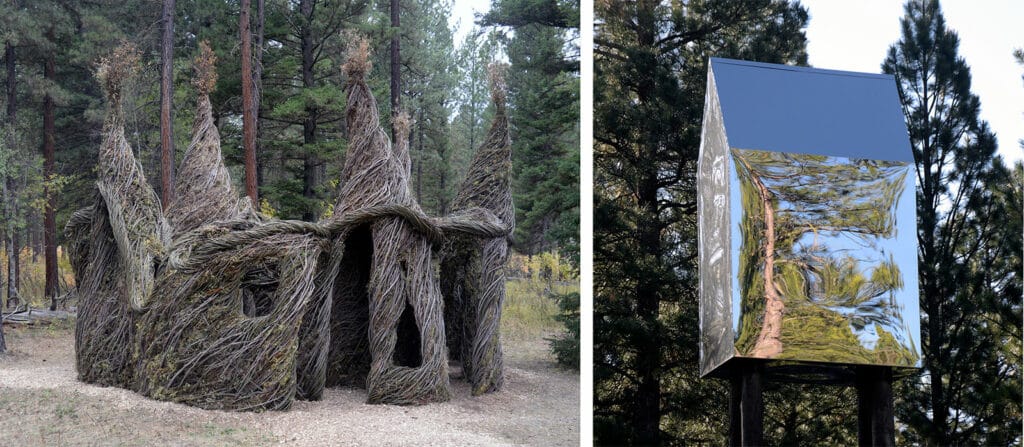Artwork: (Left) Patrick Dougherty, Tree Circus, Blackfoot Pathways: Sculpture in the Wild
Artwork: (Right) Alan Counihan, House of Sky, Blackfoot Pathways: Sculpture in the Wild

Blackfoot Pathways: Sculpture in the Wild
Children, who have grown up in Lincoln,
have their own names for each piece.
Clearing is called The Bench because two or three
can sit inside it. Only those needing shelter,
a bare interior of pine and light, choose
the charred hut as their favorite. The tomboys
go racing to The Ponderosa Whirlpool,
a vortex of trunks laid upon the ground, a nod
to our Western history of logging. Given
its declivity, it draws them in and down, until
they lose their footing, and—what fun—
fall, and so they have named this one Tornado.
The artist has placed a boulder at the center.
They imagine it is the eye, a still place
from which to view the weather’s violence.
Sculptures with interiors are still the best liked.
At some point, everyone feels a need to hide.
Under five turrets of red dogwood, each twisting
upward like a wizard’s hat, a winding path
leads to secret chambers, dungeons, and keeps,
images they might not recognize as European,
strangely out of place. Empty of thrones
and battlements, princes and kings, The Castle’s
name expresses more their longing for one.
A small child sits alone on a stump, an empty
notebook open on her lap. Before her,
the giant Picture Frame frames an assemblage
of broken sticks, but she titles it Shattered Glass.
A bridge broken in the middle—unfinished
or coming apart?—tempts them, but the hazard
tape scares them away. They don’t play
on Hill and Valley, built of stacked newspaper bales.
There are no footholds, the material too soft.
Two high school girls gossip next to a tiny house
elevated on stilts thirty feet high. Sheathed
in reflective coating, it is literally a House of Sky,
an illusion sold to settlers, an un-inhabitable
dream, a plaque explains, but the girls like
how it gives the trees a mirror to know themselves.
have their own names for each piece.
Clearing is called The Bench because two or three
can sit inside it. Only those needing shelter,
a bare interior of pine and light, choose
the charred hut as their favorite. The tomboys
go racing to The Ponderosa Whirlpool,
a vortex of trunks laid upon the ground, a nod
to our Western history of logging. Given
its declivity, it draws them in and down, until
they lose their footing, and—what fun—
fall, and so they have named this one Tornado.
The artist has placed a boulder at the center.
They imagine it is the eye, a still place
from which to view the weather’s violence.
Sculptures with interiors are still the best liked.
At some point, everyone feels a need to hide.
Under five turrets of red dogwood, each twisting
upward like a wizard’s hat, a winding path
leads to secret chambers, dungeons, and keeps,
images they might not recognize as European,
strangely out of place. Empty of thrones
and battlements, princes and kings, The Castle’s
name expresses more their longing for one.
A small child sits alone on a stump, an empty
notebook open on her lap. Before her,
the giant Picture Frame frames an assemblage
of broken sticks, but she titles it Shattered Glass.
A bridge broken in the middle—unfinished
or coming apart?—tempts them, but the hazard
tape scares them away. They don’t play
on Hill and Valley, built of stacked newspaper bales.
There are no footholds, the material too soft.
Two high school girls gossip next to a tiny house
elevated on stilts thirty feet high. Sheathed
in reflective coating, it is literally a House of Sky,
an illusion sold to settlers, an un-inhabitable
dream, a plaque explains, but the girls like
how it gives the trees a mirror to know themselves.
Melissa Kwasny

